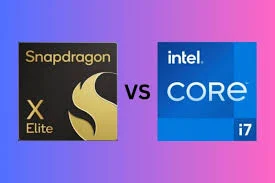Qualcomm's flagship PC offering, the Snapdragon X Elite, capitalizes on its experience with mobile-first technology. Its foundation is the proprietary Oryon CPU cores, which were created internally following Qualcomm's acquisition of Nuvia.
These cores aim for great performance with exceptional efficiency and are based on the Arm architecture, notably Arm v9.
The CPU has a 12-core single-cluster design, which is not very large. little configuration. The 4nm process used by TSMC is the fabrication node.
Architecture: entirely bespoke, ARM-based (not Cortex cores). 3.8 GHz is the maximum clock speed, with a dual-core boost to 4.3 GHz.
Meteor Lake, an Intel Core Ultra processor
Intel's innovative disaggregated tile architecture serves as the foundation for its Core Ultra processors. The CPU is divided into computing, graphics, SoC, and I/O tiles using this modular technique. A hybrid architecture is used by the CPU cores:
• CPU Cores: Efficiency (E-cores) + Performance (P-cores).
• Fabrication Node: TSMC N5 for graphics, Intel 4 (7nm-class) for compute tile.
• x86 hybrid architecture (E-core: Crestmont, P-core: Redwood Cove).
• Core Ultra Types: Depending on the model, they usually have between 6 and 14 cores. Key Architectural Takeaway: Intel uses a more intricate x86 hybrid structure intended at adaptability and backward compatibility, whereas Snapdragon has a consistent, customized ARM architecture focused on efficiency and simplicity.
2.Comparison of Performance
Performance of CPU
 |
| Intel Ultra core vs Snapdragon X Elite |
According to early benchmarks (as of 2024), the Snapdragon X Elite can sometimes rival even Core i7 and i9 mobile processors in terms of single-threaded speed, and it may even outperform Intel's Core Ultra 7 (such as the 155H). Intel's hybrid architecture performs exceptionally well in multitasking and mixed workloads, dynamically allocating threads between P and E cores;• Snapdragon's 12 high-performance cores work in tandem to provide consistently high throughput, particularly in workloads like web browsing, video conferencing, and productivity apps. However, because of its wider support for x86 and faster frequency increase on P-cores, Intel continues to have an advantage in higher peak multi-threaded workloads and legacy program performance.
GPU Performance
• Qualcomm believes that the Adreno GPU, which is a feature of the Snapdragon X Elite, can perform better than the integrated GPUs from Apple's M2 and Intel. It is designed for workloads involving media, video editing, and gaming on Arm-based systems. For light gaming and artistic tasks, the Intel Core Ultra's Arc graphics (based on the Xe-LPG architecture) provide hardware-accelerated ray tracing, XeSS upscaling, and strong integrated GPU performance. Although both GPUs are compatible with Vulkan and DirectX 12, Intel has a wider range of Windows software optimization, which gives it a leg up in a lot of PC games and apps.
3.NPU and AI Capabilities
The battlefield of contemporary processors is AI. For on-device AI operations, the Snapdragon X Elite and Intel Core Ultra are both outfitted with specialized NPUs (Neural Processing Units).
Snapdragon X Elite NPU: When the CPU, GPU, and NPU are all together, Qualcomm's Hexagon NPU can achieve up to 45 TOPS of AI performance. This makes it possible to locally execute generative AI models, such as speech recognition, image editing, and large language models (LLMs). With a total AI throughput of about 34 TOPS (CPU+GPU+NPU), the Intel Core Ultra NPU produces about 10 TOPS in the AI Boost engine. This is still a huge improvement over earlier Intel versions, although it is far lower than Snapdragon.
Key Difference: The X Elite is a good contender for AI-centric tasks like offline Copilot experiences and edge inference since Qualcomm unquestionably leads in on-device AI performance.
4.Battery Life and Power Efficiency
Energy saving has always been a top priority in Qualcomm's mobile-first architecture. Because the Snapdragon X Elite is made to operate fanless or with less cooling, tiny and light laptops can do all-day tasks with less heat production.
• In productivity use scenarios, laptops with Snapdragon processors (such as those on display in 2024–2025) frequently have 20%+ battery life.
• Intel Core Ultra laptops typically last 10 to 15 hours under comparable circumstances, though screen kind and setup affect this.
Thermal Efficiency: In designs with thermal constraints, Snapdragon systems may maintain performance for longer periods of time and typically operate cooler. More powerful cooling is frequently required for Intel systems to continue operating at their best.
5.Compatibility of Software
With native support for programs like Chrome, Microsoft Office, Adobe Photoshop, and others, Snapdragon X Elite runs Windows on ARM, which has much improved. However, it still uses x86 emulation for older Windows apps that aren't ARM-optimized. Although Windows 11's ARM64EC emulator has improved, some older or specialized apps may still experience compatibility or performance problems.
Intel Core Ultra is optimized for a wide range of enterprise and consumer software environments and runs classic Windows x86, which is nearly universally compatible with both legacy and new programs. Conclusion: Today's Intel software is more streamlined and well-known. Snapdragon is quickly catching up, but in order to achieve parity, developers must completely embrace native ARM programs.
6.Platform Integration and Ecosystem
Snapdragon X Elite
• Because of its mobile pedigree, it has strong integration with 5G, Wi-Fi 7, Bluetooth LE Audio, and ultra-low-power sensing.
• The advantages of the ARM ecosystem include tight hardware-software optimization, like to those of Apple Silicon.
• Deeply ingrained AI-powered features include real-time translation, camera effects, and on-device Copilot.
Intel Core Ultra
•A vast OEM ecosystem with reputable peripherals, firmware, and drivers.
• Outstanding compatibility with legacy gear, PCIe 5.0, and Thunderbolt 4.
• smooth integration for enterprise deployments with Intel Vpro.
7.Prospects of the Future
• A daring attempt to challenge the Intel-AMD duopoly in Windows laptops is Qualcomm's Snapdragon X Elite. Its AI-first strategy is in line with the direction of computing, and it is aiming for Apple Silicon in terms of efficiency and performance. Snapdragon's market share may increase dramatically if developers start to support ARM64 natively.
In order to reimagine itself in the face of competition from Apple and Arm, Intel has included the Core Ultra in their multigenerational roadmap (Lunar Lake, Panther Lake). Intel is still a formidable rival thanks to ongoing advancements in AI, efficiency, and tile-based design, particularly in corporate and legacy-heavy settings.
Conclusion
For whom is the Snapdragon X Elite the best option?
• Users that value on-device AI capabilities, silent operation, and long battery life.
• Experts who use native ARM apps (such as Microsoft 365, Zoom, and Chrome) and reside in the web/app environment.
• Users who are tech-savvy and open to the changing Windows on ARM environment.
For whom is the Intel Core Ultra the best option?
Why Users require the highest level of software compatibility, particularly for specialized x86
applications.
• Professionals, developers, and gamers who depend on custom workflows or older software.
• Businesses seeking an established platform with strong management and security features.
Both processors—one driven by legacy transformation (Intel) and the other by mobile innovation (Snapdragon)—mark a watershed in the evolution of the PC. The balance you require between compatibility, efficiency, and creativity will determine the option you choose.







Post a Comment